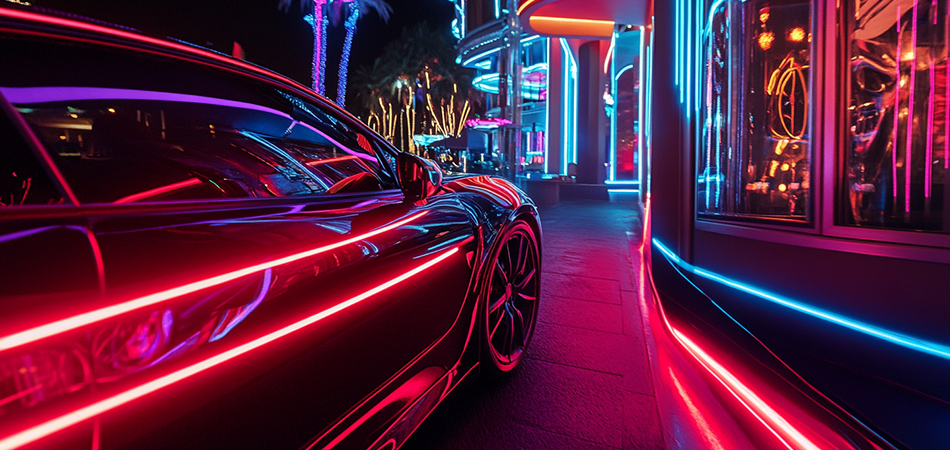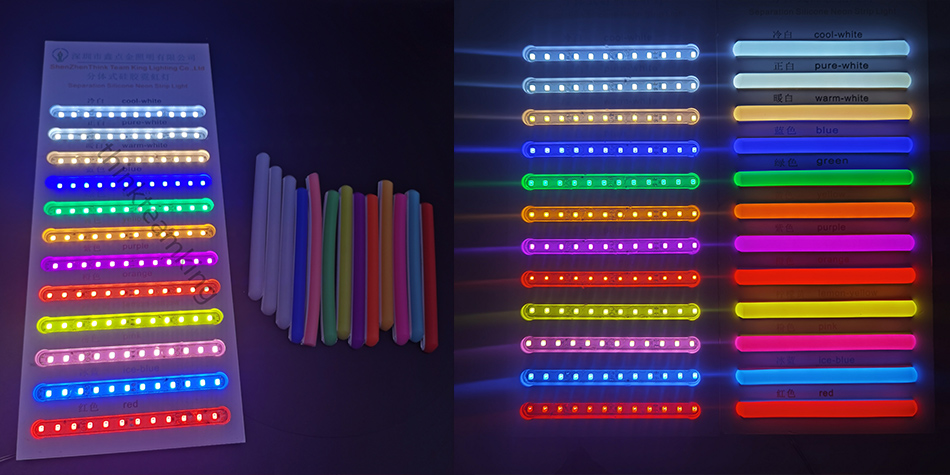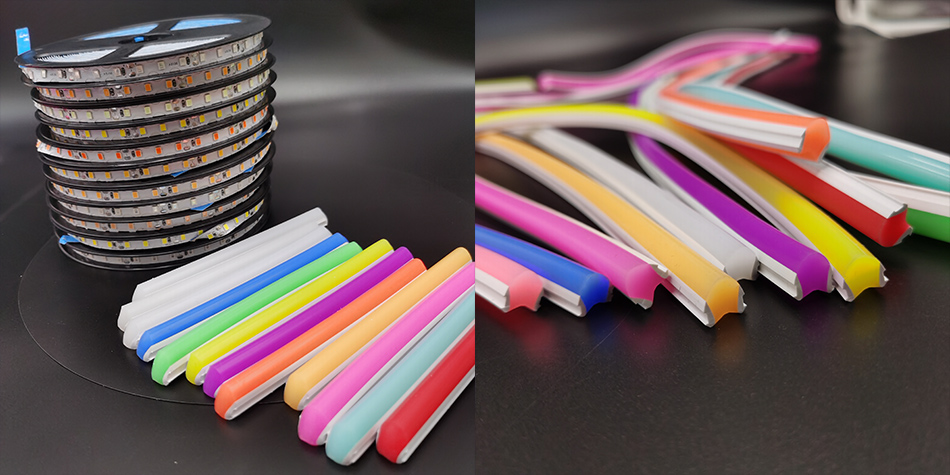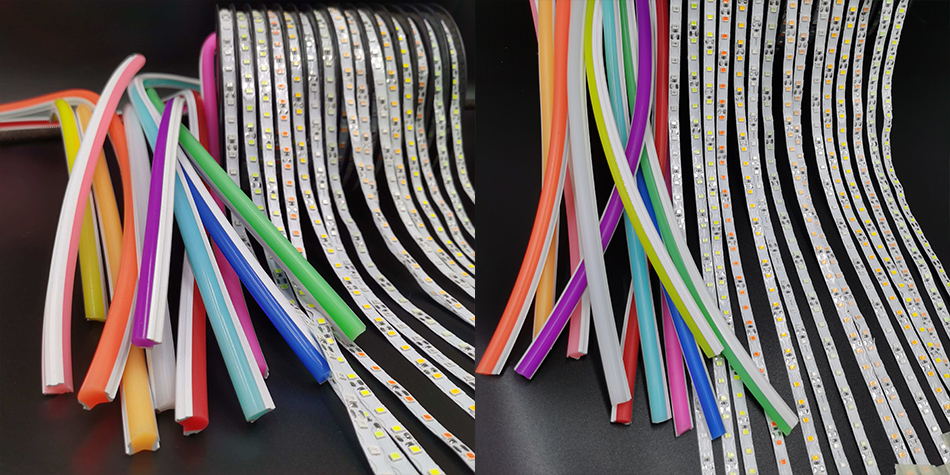Time:2025-06-27
In the automotive industry, where innovation and customization are highly valued, flexible silicone neon LED strips have emerged as a revolutionary addition. These strips combine the flexibility of silicone materials with the energy - efficiency and brightness of LED technology, offering a wide range of benefits for vehicle owners. Whether it's for enhancing the aesthetic appeal, improving functionality, or adding a touch of personalization, flexible silicone neon LED strips have become an increasingly popular choice. This article explores the various aspects of these strips, from their construction and features to their applications, installation, and future trends in the automotive field.
Construction and Technology of Flexible Silicone Neon LED Strips for Vehicles
The Flexible Silicone Casing
The outer casing of these LED strips is made from high - quality silicone, which is the key to their flexibility. Silicone is a synthetic polymer known for its remarkable ability to bend and conform to various shapes without losing its structural integrity. This flexibility allows the LED strips to be easily installed in the often - complex and irregular spaces within a vehicle. Whether it's along the curved edges of a dashboard, around the contours of a wheel well, or inside the tight spaces of a door panel, the silicone - coated strips can adapt effortlessly.
Moreover, silicone provides excellent protection to the internal components. It is highly resistant to temperature fluctuations, which are common in automotive environments. Vehicles can experience extreme heat during summer days and cold temperatures in winter, and the silicone casing ensures that the LED strips remain functional under these varying conditions. Additionally, silicone is durable and resistant to abrasion, protecting the strips from potential damage caused by vibrations, friction, or accidental impacts within the vehicle.
The LED Lighting Elements
Inside the silicone casing, the LED lighting elements are the core of the strips. LEDs, or Light - Emitting Diodes, are semiconductor devices that convert electrical energy into light. They are chosen for their numerous advantages over traditional lighting sources. LEDs are highly energy - efficient, consuming significantly less power while still providing a bright and vivid illumination. This is crucial for vehicles, as it helps to minimize the load on the vehicle's electrical system, especially when multiple strips are installed.
LEDs also have a long lifespan, reducing the need for frequent replacements. In a vehicle, where accessing and replacing lighting components can be challenging, the long - lasting nature of LEDs is a major benefit. Furthermore, LEDs can produce a wide range of colors, either in a single - color configuration or through RGB (Red, Green, Blue) technology, which enables color - changing effects. This color versatility allows vehicle owners to customize the lighting to match their preferences or the overall theme of their vehicle's interior or exterior.
Electrical and Connectivity Components
Flexible silicone neon LED strips for vehicles come with specific electrical and connectivity components. A power adapter or driver is often included to convert the vehicle's electrical supply to the appropriate voltage and current required by the LED strips. This ensures that the strips operate safely and efficiently.
Connectors are another essential part of these strips. They are used to join multiple strips together, allowing for longer lighting runs or more complex lighting setups. The connectors are designed to provide a secure and reliable electrical connection, preventing issues such as loose connections that could lead to flickering or non - functioning lights. Some strips also feature quick - connect or plug - and - play connectors, making the installation process more convenient for vehicle owners.

Key Features and Benefits of Flexible Silicone Neon LED Strips for Vehicles
Customizable Aesthetic Appeal
One of the most significant advantages of these LED strips is their ability to enhance the aesthetic appeal of vehicles. With the wide range of colors and lighting effects available, vehicle owners can create a unique and personalized look. For the interior, strips can be installed under seats, along door panels, or around the dashboard to create a soft, ambient glow. This not only adds a touch of style but also creates a more inviting and comfortable atmosphere inside the vehicle.
On the exterior, flexible silicone neon LED strips can be used to accentuate the vehicle's lines, highlight the wheels, or create a distinctive lighting pattern. For example, installing strips along the bottom edge of the vehicle can give it a sleek, low - riding appearance. The ability to customize the color and lighting effects also allows vehicle owners to match the strips to the vehicle's paint color or to create a lighting display for special occasions or events.
Improved Functionality and Safety
In addition to their aesthetic benefits, these LED strips can also improve the functionality and safety of vehicles. In the interior, they can provide additional lighting for tasks such as finding items in the glove compartment or reading maps at night. The soft, diffused light of the LED strips is less harsh on the eyes compared to traditional vehicle interior lights, reducing glare and making it easier to see in the dark.
On the exterior, certain types of LED strips can be used to enhance visibility. For example, installing strips on the rear of the vehicle can make it more noticeable to other drivers, especially in low - light conditions or during adverse weather. Some strips can also be programmed to flash or blink in specific patterns, which can serve as a warning signal or add an extra layer of safety.
Durability and Reliability
The combination of the flexible silicone casing and high - quality LED components makes these strips highly durable and reliable. The silicone casing protects the LEDs from the harsh automotive environment, including dust, moisture, and vibrations. This ensures that the strips can withstand the rigors of daily use in a vehicle without deteriorating quickly.
LEDs, with their long lifespan, also contribute to the reliability of the strips. Vehicle owners can expect the LED strips to last for a significant period, reducing the frequency of maintenance and replacement. This durability and reliability make flexible silicone neon LED strips a cost - effective choice for vehicle lighting upgrades.
Energy Efficiency
Energy efficiency is a crucial factor in vehicle lighting, and flexible silicone neon LED strips excel in this aspect. LEDs consume much less power than traditional lighting sources, such as incandescent bulbs. This reduced power consumption not only helps to save on the vehicle's battery life but also minimizes the impact on the vehicle's electrical system.
For vehicles with limited electrical capacity, such as electric or hybrid cars, the energy - efficient nature of these LED strips is especially beneficial. It allows vehicle owners to add lighting enhancements without overloading the electrical system or reducing the vehicle's overall range.

Applications of Flexible Silicone Neon LED Strips in Vehicles
Interior Vehicle Lighting
The interior of a vehicle offers numerous opportunities for the installation of flexible silicone neon LED strips. One popular application is under - seat lighting. Installing strips under the seats can create a soft, ambient glow that adds a touch of luxury and style to the interior. This lighting can also be useful for passengers, providing a subtle illumination that makes it easier to move around inside the vehicle at night.
Dashboard lighting is another common use. By installing LED strips along the edges of the dashboard or around the instrument cluster, vehicle owners can enhance the visibility of the controls and create a more visually appealing driving environment. Door panel lighting is also possible, with strips installed to highlight the contours of the doors or to provide additional lighting when the doors are opened.
Exterior Vehicle Lighting
On the exterior, flexible silicone neon LED strips can be used in a variety of ways. One of the most popular applications is for accent lighting. Strips can be installed along the front grille, around the headlights or taillights, or along the body lines of the vehicle to create a unique and eye - catching look. This accent lighting can make the vehicle stand out on the road and add a personalized touch to its appearance.
Wheel well lighting is another growing trend. By installing LED strips inside the wheel wells, vehicle owners can create a striking visual effect, especially when the vehicle is in motion. This not only looks impressive but can also make the vehicle more visible to other road users. Additionally, some vehicle owners use LED strips for under - body lighting, which gives the vehicle a low - flying, futuristic appearance.
Specialty and Custom Vehicle Applications
For specialty and custom vehicles, such as show cars, race cars, or off - road vehicles, flexible silicone neon LED strips offer even more creative possibilities. In show cars, these strips can be used to create elaborate lighting displays that showcase the vehicle's unique features and design. Race cars may use LED strips for functional purposes, such as indicating the vehicle's status or providing additional lighting for the driver during night races.
Off - road vehicles can benefit from LED strips for improved visibility in rugged terrain. Strips can be installed on the roof rack, around the bumpers, or on the undercarriage to provide better illumination when navigating through dark or challenging environments.

Installation Considerations for Flexible Silicone Neon LED Strips in Vehicles
Preparation and Planning
Before installing the LED strips, thorough preparation and planning are essential. First, vehicle owners should decide on the location and layout of the strips. This involves considering factors such as the desired lighting effect, the available space, and the ease of installation. It's also important to ensure that the installation does not interfere with any of the vehicle's existing components or systems.
Next, the vehicle's electrical system should be evaluated to determine the appropriate power source for the LED strips. Some strips can be connected directly to the vehicle's battery, while others may require a connection to a specific fuse or switch. It's crucial to follow the manufacturer's instructions regarding the electrical connection to avoid any potential issues.
Surface Preparation and Mounting
The surface where the LED strips will be installed should be clean, dry, and free of any debris. This ensures that the adhesive backing (if the strips have one) or the mounting clips can adhere properly. If the surface is rough or uneven, it may be necessary to use additional mounting accessories or to prepare the surface further.
For strips with adhesive backing, carefully peel off the protective layer and press the strip firmly onto the surface, starting from one end and working towards the other. Make sure to smooth out any air bubbles or wrinkles as you go. For more permanent or heavy - duty installations, mounting clips or screws can be used, following the manufacturer's guidelines.
Electrical Connection and Wiring
Connecting the LED strips to the vehicle's electrical system requires caution. If connecting to the battery, make sure to use the correct polarity to avoid damaging the strips. When running the wiring, it's important to route it safely and neatly, avoiding any moving parts or areas where it could be pinched or damaged.
In some cases, a relay or a switch may be required to control the LED strips. This allows for more convenient operation, such as turning the strips on and off with the vehicle's ignition or a separate switch. When installing a relay or switch, follow the wiring diagram carefully to ensure proper functionality.

Maintenance and Troubleshooting of Flexible Silicone Neon LED Strips in Vehicles
Regular Inspection and Cleaning
To ensure the optimal performance of the LED strips, regular inspection and cleaning are recommended. Periodically check the strips for any signs of damage, such as cracks in the silicone casing, loose connections, or a decrease in light output. If any damage is detected, it's important to address the issue promptly to prevent further problems.
Clean the strips gently using a soft, dry cloth to remove any dust, dirt, or debris that may have accumulated on the surface. Avoid using harsh chemicals or abrasive cleaners, as they can damage the silicone and affect the performance of the strips.
Troubleshooting Common Issues
If the LED strips are not working properly, there are several common issues to check. First, verify the electrical connection. Make sure that the power source is providing the correct voltage and that all connections are secure. A loose or damaged connection can cause the strips to flicker, dim, or not light up at all.
If the electrical connection is fine, check the LED strips themselves for any signs of physical damage. A damaged strip may need to be replaced. In some cases, if only a section of the strip is not working, it may be possible to isolate and repair the problem, but this often requires technical expertise. Additionally, if the strips are color - changing or have special lighting effects, check the controller or the settings to ensure they are configured correctly.
Trends and Future Developments in Flexible Silicone Neon LED Strips for Vehicles
Smart Lighting Integration
One of the emerging trends in vehicle lighting is the integration of smart technology with flexible silicone neon LED strips. Smart LED strips can be controlled using a smartphone app, a vehicle's onboard infotainment system, or a voice - activated assistant. This allows vehicle owners to adjust the color, brightness, and lighting effects of the strips remotely, providing greater convenience and customization.
Smart lighting systems also enable features such as scheduling, where the strips can be set to turn on and off at specific times. Additionally, some smart strips can be programmed to respond to certain events, such as turning on when the vehicle's doors are opened or changing color based on the vehicle's speed.
Advancements in LED and Material Technologies
As LED and material technologies continue to evolve, we can expect to see further improvements in flexible silicone neon LED strips for vehicles. Newer LED chips may offer even higher brightness levels, better color rendering, and improved energy efficiency. This will enhance the visual impact of the strips while reducing their power consumption.
In terms of materials, there may be developments in silicone formulations that offer even greater flexibility, durability, and resistance to extreme conditions. These advancements will make the strips more adaptable to different vehicle designs and environments, and will also increase their lifespan and reliability.
Integration with Vehicle Safety and Autonomous Systems
In the future, flexible silicone neon LED strips may be integrated with vehicle safety and autonomous systems. For example, the strips could be used to communicate information to other road users, such as indicating when the vehicle is braking, turning, or accelerating. In autonomous vehicles, the strips could play a role in signaling the vehicle's intentions or status to pedestrians and other drivers, enhancing overall road safety.
This integration could also extend to vehicle - to - vehicle (V2V) and vehicle - to - infrastructure (V2I) communication systems, where the LED strips could be used as part of a visual communication network to improve traffic flow and safety on the roads.
In conclusion, flexible silicone neon LED strips have become an important and versatile addition to the automotive industry. Their unique combination of flexibility, durability, energy efficiency, and customizable lighting effects makes them a popular choice for vehicle owners looking to enhance the aesthetic appeal, functionality, and safety of their vehicles. As technology continues to advance, we can expect these strips to play an even more significant role in the future of automotive lighting, with exciting developments in smart integration, material advancements, and safety - related applications on the horizon.